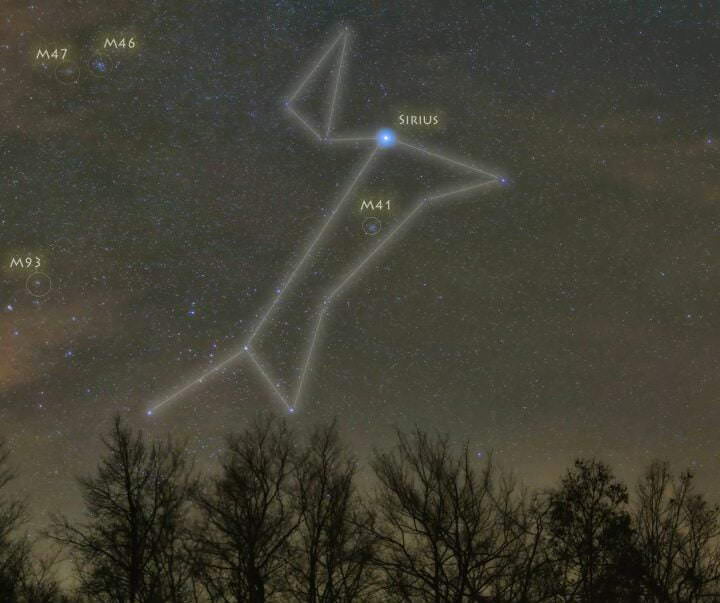Shining even brighter than the Sun and located relatively close to Earth, Procyon, the second “dog” star in the sky, has a significant place in both ancient and modern astrophysics. This celestial body, which defies the laws of modern astrophysics, was first observed by the people of antiquity.
Why Procyon is called Procyon
Procyon – a star of great brightness, easily visible from Earth even without the aid of a telescope. This characteristic caught the attention of ancient civilizations such as Babylon and Egypt, who revered celestial bodies. Among their revered stars was Sirius – the brightest star (alpha) in the constellation Canis Major, also known as the Big Dog.
The name Procyon has its origins in ancient Greece.
Its name is derived from the Greek word προ κύων (Prokyōn), which translates to “before the dog”.
Source: Wikipedia
Procyon is the leading star that precedes Sirius in the night sky. The rotation of the Earth is responsible for this phenomenon. Despite its more direct trajectory as it rises above the horizon in northern latitudes, Procyon actually appears earlier because of its declination towards that particular region and its more easterly position.
An interesting tidbit of information is that the raccoon is actually named after Procyon. The scientific name for the raccoon is Procyon, which translates to “pre-dog”.
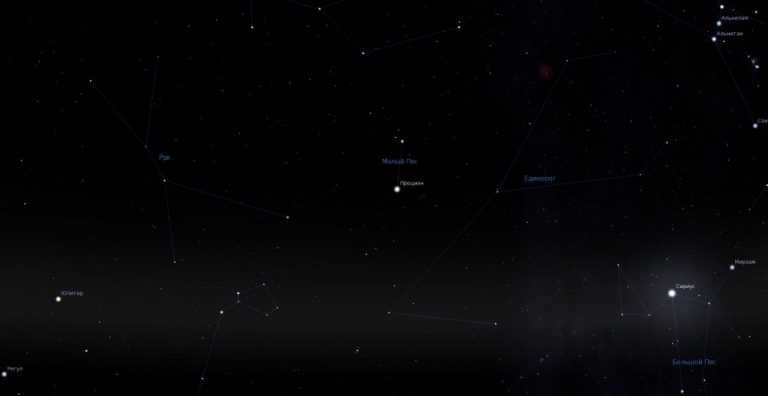
"The Lesser Dog’s Dog Star."
The star Procyon is located in the constellation of the Lesser Dog, which is why it is commonly referred to as the alpha of the Lesser Dog, similar to how Sirius is the alpha of the Greater Dog.
The Lesser Dog, also known by its Latin name Canis Minor (CMi), has been recognized since ancient times as a collection of bright stars, listed in the catalog known as the "Almagest," which dates back to around 140 AD. Procyon is already noted as the brightest star in Canis Minoris within this catalog. The Lesser Dog shares its boundaries with several other constellations, including Gemini, Hydra, Unicorn, and Cancer. In relation to the Milky Way, the Lesser Dog is symmetrically aligned with the constellation Orion.
Ancient celestial charts portray both star canines as companions of the hunter Orion, despite the fact that the ancient Greek myths only mention the Great Dog. The Small Dog is believed to be derived from one of Actaeon’s dogs, a hunter and renowned warrior who was the grandson of Apollo. He was torn apart by his own dogs while in the form of a deer, as decreed by Artemis, the goddess of hunting and protector of the living world.
There is also a mythological version of the origin of the star Procyon itself. It is said to be Mera (also known as Myra), the loyal dog of Icarius’ daughter, the first winemaker, who was killed by Athenian shepherds. Mera was the one who discovered the body. There is a belief that Mera transformed into Sirius.
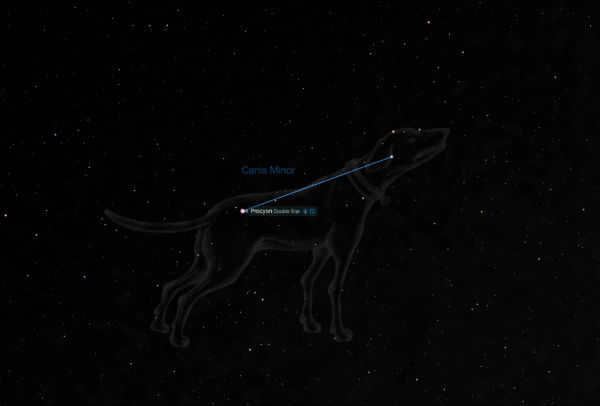
Winter Triangle, Egyptian Cross, and Winter Circle
The star Procyon is associated with an astronomical pattern known as the Winter Triangle. An astronomical pattern is a collection of stars that are prominent in the sky but are not part of any specific constellation, although these terms are often mistakenly used interchangeably.
The Winter Triangle consists of two stars resembling dogs and the alpha star of the constellation Orion, Betelgeuse. This pattern can be observed in the Northern Hemisphere from autumn to early spring, but it is most visible during the winter months.
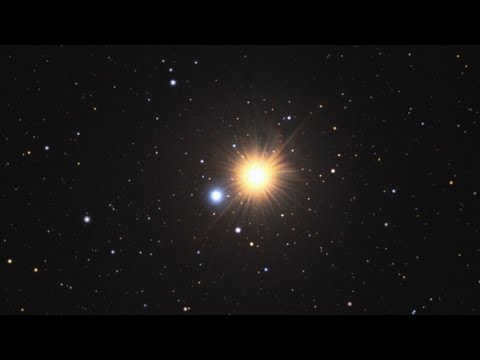
On many occasions, the Winter Triangle is accompanied by a couple of additional bright stars: Fact, which is the alpha star in the Dove constellation, and Naos, the brightest star in Corma constellation. This combination of stars is also known as the Egyptian Cross. It is worth noting that the Corma constellation did not exist as an independent constellation until 1752, when the larger Argo Ship constellation was divided into three parts (the other two parts being Sails and Keel).
All the points of the Winter Triangle are part of a larger seasonal asterism. Procyon and Sirius, along with six other bright stars, form a circle. Betelgeuse is considered the central star of the Winter Circle. This group of stars, like the Winter Triangle, is located in the equatorial region of the celestial sphere and can be seen during the same seasons.
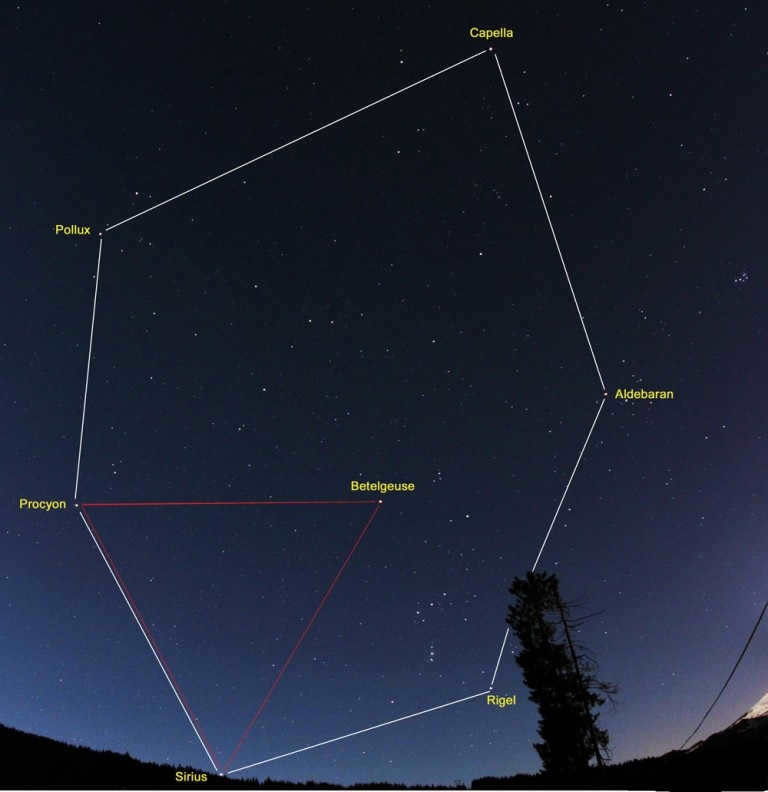
The Distance between Earth and Procyon
Procyon, a star located near our planet and solar system, is approximately 11.41 light years away. This equates to a distance of 3.5 parsecs.
The determination of distances to celestial objects and the validation of the Earth’s rotational motion around the Sun are closely tied to the concept of parallax. The term “parsec” itself is a unit of measurement used in astronomy.
Parsek (Russian: пк; international: pc) is a unit of measurement used in astronomy to represent the distance to an object. It is defined as the distance to an object whose annual trigonometric parallax is equal to one arc second. The name “parsec” is derived from the words “parallax” and “second”.
“Wikipedia”
The annual parallax of a star refers to the change in the star’s coordinates caused by the displacement of the observer. This displacement occurs due to the Earth’s rotation around the Sun. The annual parallax is measured as the angle at which the semi-major axis of the Earth’s orbit is visible from the star’s location.
The parallax of the star Procyon is measured to be 286.05 arc seconds with a margin of error of +/- 0.81.
Procyon A and Procyon B
Procyon is categorized as a binary star system. It was the second celestial body for which an undetectable natural companion (due to the absence of advanced technology in 1806) was proposed. This discovery was groundbreaking at the time, considering that even the most powerful telescopes could only provide limited visibility.
The primary star of Procyon belongs to the spectral classification F, yet it shines too brightly even for its class. It surpasses the size and luminosity of the central star in our solar system, thus being classified as a subgiant. Stars of this nature have already begun the process of expansion, as the fusion of helium and hydrogen within them has reached completion.
Consequently, the celestial entity is expected to expand its original size by several tens of times (estimated to be between 8 and 15) and assume a hue of orange or red. These transformations will occur over the course of millions of years. However, the predictions are highly approximate, and preliminary assessments differ. The timeframe could span from ten to one hundred million years. Similar forecasts are applicable to the Sun.
In the latter part of the summer in 2004, an observation period lasting over one month was conducted on Procyon A. The MOST satellite telescope was utilized for diagnostic purposes. The objective of the research was to validate the fluctuations in the star’s luminosity observed from our planet’s surface. Nonetheless, the data was inconclusive, prompting a reevaluation of the established principles of helioseismology and a reassessment of theoretical assumptions regarding the genesis of celestial bodies of this nature.
Procyon B is located at a similar distance from Procyon A as Uranus is from the Sun (approximately sixteen astronomical units away). This dim dwarf possesses a white luminosity, making it quite challenging to observe with non-professional optical instruments.
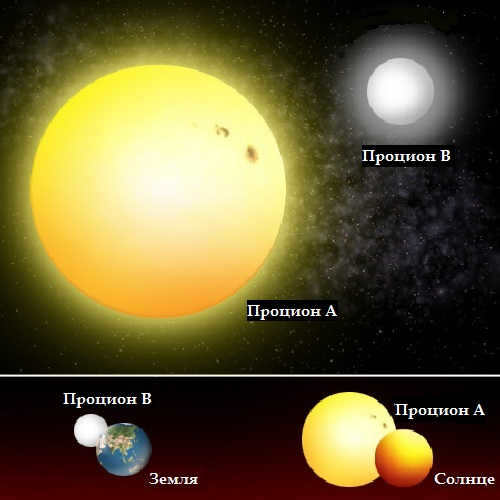
When, where, and the optimal way to observe
The alpha and beta stars of the Canis Minor constellation are Procyon and Gomeisa (also known as Gomeisa). The best conditions for observing the entire group of stars, especially the brightest ones, are found in the southern regions of Russia during the second and third winter months. However, celestial events can be seen throughout the entire Russian Federation and Ukraine.
Procyon is further away, but it shines brighter than the Sun by 7.5 times, making it visible without the need for special optical equipment. The more advanced the observation equipment, the better you will be able to see both the star and the constellation it belongs to.

Procyon: Its Significance in Astrology
Astrologers view Procyon as a symbol of abundance, achievement, good luck, and renown. During the Middle Ages, celestial observers associated it with magical attributes. Agate is recognized as the stone associated with this star, while buttercup is its corresponding plant.
Procyon belongs to the category of bright stars, which exert a significant influence on individuals with them in their astrological birth chart:
- These individuals experience destinies that differ from the norm, often encountering extraordinary occurrences.
- They possess the ability to impact not only their own lives and the lives of their loved ones, but also those of numerous others.
- The star endows the life of the person it patronizes with a specific purpose and a higher calling.
- Individuals who possess light stars in their horoscope are under the vigilant observation of higher forces.
- If such an individual can manage their ego and self-love, they will provide themselves with protection from malevolence.
- If this star is aligned with a planet or the cusp (boundary) of an astrological house within a very short period of time – from 1 to 4 minutes – its influence on the individual becomes incredibly potent, capable of altering their entire destiny as delineated by the rest of their personal horoscope. The status of such a brilliant star is formidable.
The brilliant star Procyon manifests at 26° of the Cancer zodiac sign. In this instance, it bestows its charge with a formidable energy of vitality, the ability to heal, and productive determination. In the event of involvement in combat, the individual has a greater likelihood of survival due to their own faith and inherent survivability.
The astronomical constellation known as “Canis Major” is symbolized by Sirius, one of the most luminous stars visible in the nighttime sky. Its name, derived from the Greek language, translates to “shining brightly.” In terms of luminosity, Sirius surpasses the Sun by a factor of 23. It is important to mention that there are stars with luminosities hundreds and even thousands of times greater than the Sun. Positioned at a distance of 8.6 light years from Earth, Sirius stands as one of the nearest stars to our planet, which contributes to its remarkable brightness.
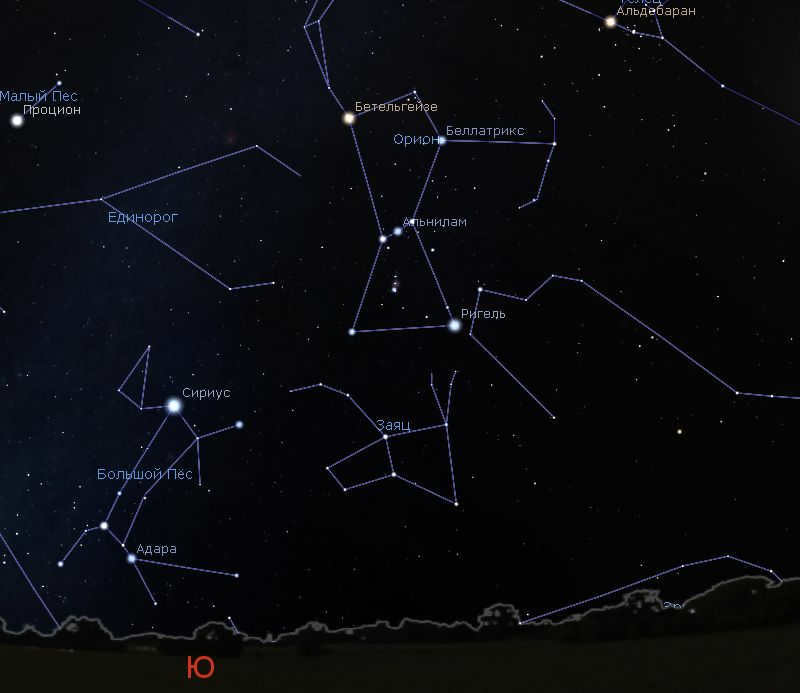
The Origins of the Name Big Dog
In the distant past, the star Sirius went by many different names. In the ancient civilization of Egypt, it was known as the star of the Nile, as its first morning rise coincided with the start of the Nile’s annual flooding. Among the Sumerians, it held the title of the Dog of the Sun, while the Greeks simply referred to it as the Dog.
A Stellar Companion
In the 19th century, a significant discovery was made thanks to Sirius – the identification of peculiar stars known as “White Dwarfs”.
In 1836, German astronomer Bessel F. observed Sirius and proposed the existence of an unseen satellite. This conclusion was the result of meticulous measurements conducted over several years. Friedrich Bessel published his findings in 1844, noting that the satellite completes one orbit approximately every 50 years. However, Bessel faced intense criticism from his peers following this publication. In those times, the idea of invisible stars was not even considered.
In 1846, J. Adams and W. Leverrier made a groundbreaking discovery based on their observations of Uranus. They predicted the existence of an undisclosed planet within our solar system. To their astonishment, their prediction was proven correct when the planet Neptune was discovered shortly after. It is worth noting that Bessel’s earlier prediction had remained unconfirmed for nearly two decades.
In 1862, the American optician Clark Alvan confirmed a prediction by discovering a companion to Sirius while testing a new telescope. This companion, known as Sirius B and affectionately nicknamed “the puppy,” is significantly dimmer than Sirius, with a brightness that is 1000 times fainter. It is also much smaller than the Sun, being only a hundred times its size, but surprisingly, it has a mass that approaches that of the Sun. What is particularly notable about “Sirius B” is its incredibly high density, measuring up to 1 ton per cubic centimeter. This discovery led to the identification of “white dwarfs,” which are objects that have reached the end of their evolutionary cycle. In the case of Sirius B, it orbits the main planet with the characteristics specified by Bessel.
A dazzling area of celestial bodies
Located in the southern sky, one can view the captivating star cluster M41 in close proximity to Sirius. This assemblage is situated at an impressive distance of 2,300 light-years. In the constellation known as Canis Major, there exists another intriguing star, Tau of the Big Dog (τ CMa) with a magnitude of 4. It serves as the most radiant celestial body within the dispersed star cluster NGC 2362. Remarkably, this cluster is considered to be one of the most youthful, with an age of less than one million years.

Canis Major, also known as the Great Dog, is a constellation situated in the southern sky. The most prominent star in this constellation is Sirius, which has a luminosity of -1.46 m. The optimal time for observing Canis Major is in December and January. It is positioned to the southeast of Orion, specifically “under the right foot.” Additionally, Canis Major intersects with the Milky Way. In Russia, this constellation can be observed in its entirety in the southern and central regions, and partially in the northern regions.
History
The Big Dog is an ancient constellation that takes the shape of a dog, formed by a group of bright stars, with its main star being Sirius. The constellation has a rich history and is associated with various myths and legends. In Greek mythology, the Celestial Dog is believed to be either the dog Orion or Icarius. The constellation is listed as “Dog” in Claudius Ptolemy’s Almagest catalog of the night sky.
Sirius
The Brightest Star in the Night Sky
Sirius, also known as the Dog Star, is the brightest star in the night sky. It is located in the constellation Canis Major and is visible from almost every inhabited region of the Earth. Sirius is a binary star system, consisting of a main-sequence star called Sirius A and a white dwarf companion called Sirius B.
Sirius has been known since ancient times and has a prominent place in many cultures and mythologies. In ancient Egypt, Sirius was associated with the goddess Isis and played a significant role in the Egyptian calendar. In Greek mythology, Sirius was said to be the hunting dog of the giant Orion.
With an apparent magnitude of -1.46, Sirius is the brightest star in the night sky, outshining even the other well-known bright stars like Vega and Arcturus. It is also one of the closest stars to Earth, located at a distance of about 8.6 light-years.
Recent studies have shown that Sirius is a relatively young star, with an estimated age of about 200 to 300 million years. It is much hotter and more massive than the Sun, with a surface temperature of about 9,940 Kelvin and a mass about twice that of the Sun.
Sirius is easily recognizable in the night sky due to its brightness and its location near the celestial equator. It can be seen from almost every inhabited region of the Earth and is visible even in light-polluted areas. Sirius is a popular target for amateur astronomers and is often used as a reference point for calibrating telescopes.
This constellation encompasses the most luminous star in the whole expanse of the firmament, Sirius (α of the Big Dog), which possesses a stellar magnitude of -1.46 m. This azure-white star appears so brilliantly incandescent (its appellation is derived from the Greek seirios, “radiantly aflame”) due to its proximity of merely 8.57 light-years. The resplendence of Sirius is augmented by its luminosity, which surpasses that of the Sun by 23 times. In the ancient land of Egypt, Sirius was titled the “Star of the Nile” as its initial dawn ascension heralded the inundation of the Nile during the summer solstice. Furthermore, Sirius and the constellation itself were already linked to a canine creature five millennia ago; its earliest Sumerian moniker was “dog of the sun,” the Greeks referred to it simply as “dog,” and the Romans designated it as “doggie” (Canicula, hence the period of summer vacation – holiday). For some inexplicable reason, Seneca and Claudius Ptolemy regarded Sirius as a vivid crimson star.
Sirius B
In 1844, F. Bessel observed the oscillating motion of Sirius and proposed the existence of a companion. This companion, known as Sirius B or “Puppy,” was later discovered by A. Clarke in 1862. Sirius B is much dimmer than its main star, Sirius A, with a luminosity 10,000 times fainter. It also has a radius 100 times smaller than the Sun, but its mass is nearly the same. As a result, Sirius B has an incredibly high density of approximately 1 t/cm³. This discovery led to the identification of white dwarfs, which are stars that have completed their evolution and contracted to the size of a small planet. Sirius B orbits around Sirius A at a distance ranging from 3 to 11.5″ and has a period of 49.98 years.
Additional items
M 41 is a stunning dispersed cluster located 4 degrees south of Sirius, and it is approximately 2350 sv years away. NGC 2362 is another interesting cluster that features several dozen stars surrounding the fourth magnitude star τ in the Big Dog constellation. This cluster is considered one of the youngest, with an estimated age of around 1 million years.
Within the Big Dog constellation, you can find one of the largest and brightest stars ever discovered by humans – the hypergiant VY Big Dog. This massive star has a diameter of approximately 2.5-2.9 billion kilometers, which is equivalent to about 17-19 astronomical units.
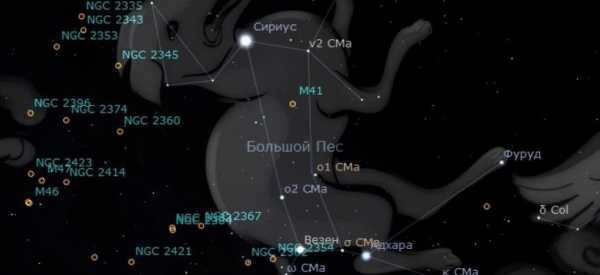
Star patterns
The star pattern known as the Big Dog constellation derives its designation from the Latin term “Canis Major,” signifying “Big Dog.” Upon careful observation, one can discern that the collection of stars bears a striking resemblance to that of a canine.
A concise explanation of the star group
Situated in the Southern Hemisphere, this star group was initially identified by the ancient Greek scholar Ptolemy. It emits a luminosity that is 20 times more powerful than the Sun. The distance from the constellation Canis Major to our planet is approximately 8.5 million light years. It holds the 43rd position when it comes to its expansive region. Due to its low elevation during daytime, it can only be observed for a limited duration.
The star group Canis Major can be easily spotted in the sky, primarily because of the brilliant presence of Sirius. This cluster also encompasses the well-known astronomical object, Messier 41, the Dwarf Galaxy, and Thor’s Helmet.
To the south of Sirius lie the less conspicuous neighboring star groups, Columba and Corvus, while to the north is Monoceros, also known as the Unicorn. Above Canis Major is the constellation Orion.
There are currently no known meteor streams in the constellation of the Big Dog. However, the cluster of stars in this constellation is easily visible in latitudes ranging from +60° to -90°. In Russia, the best time to observe the Big Dog constellation is during the winter months.
Notable Objects in the Big Dog Constellation
Now let’s explore the interesting objects within the Big Dog constellation. One of the most prominent stars is Sirius, also known as Alpha of the Big Dog. Sirius is the fifth closest star to our solar system and holds the title of the brightest star in the sky. With an apparent visual magnitude of 1.42, Sirius is often referred to as the Dog Star. It forms the Winter Triangle alongside other stars such as Procyon and Betelgeuse. This triangular pattern can be observed in the northern sky from December through March.
Messier 41 (or M41) is a group of approximately 100 stars. This astronomical discovery was made in the 17th century by Giovanni Batista Hodierne, an Italian astronomer. Situated 4 degrees south of Sirius, the cluster has a diameter of 25 to 26 light-years. Notably, M41 contains multiple red-emitting giant stars.
Also known as the Small Beehive, Messier 41 is large enough to be visible with binoculars, spanning about 38 degrees in diameter. However, it is not advisable to observe M41 through a telescope as the entire cluster will not fit within the lens.
A dwarf galaxy, shaped like an ellipse, was first observed by an international team of astronomers 15 years ago. This galaxy is known to be one of the closest to Earth, positioned approximately 42 thousand light years away from the Galactic Center. With an estimated billion stars, it is quite challenging to study due to its location behind a layer of dust and gas.
Thor’s Helmet, also referred to as NGC 2359, is an emission nebula that resembles a helmet and is located 15,000 light years away from our planet. Despite emitting dim light due to its vast size, under optimal weather conditions, even amateur astronomers can catch a glimpse of this celestial phenomenon. The discovery of Thor’s Helmet dates back to the late 18th century.
Origin of the Big Dog constellation: myths and legends from various cultures
Ancient civilizations such as the Egyptians, Incas, Chinese, Aztecs, Greeks, Mayans, and others all made references to the prominent star cluster known as the Big Dog. These cultures saw Sirius, the most significant star in the cluster, as a representation of a dog, and this concept evolved over time.
The ancient Egyptians believed that Sirius, the brightest star in the sky, was responsible for causing floods. They believed that it would illuminate when the Nile overflowed its banks.
The Romans referred to Sirius as the Dog Star. In the 3rd century BC, Roman farmers believed that the intense heat during the summer months was attributed to Sirius, and they called this period the “dog days.” Historical records even mention the sacrifice of dogs for the purpose of ensuring good harvests.
During the ancient times in China, Tien-lang was the name given to Sirius. The bow and arrow were regarded as significant in the southern stars by the ancient Chinese. According to their mythology, these weapons were used to slay the “celestial jackal” who had been bothering an emperor.
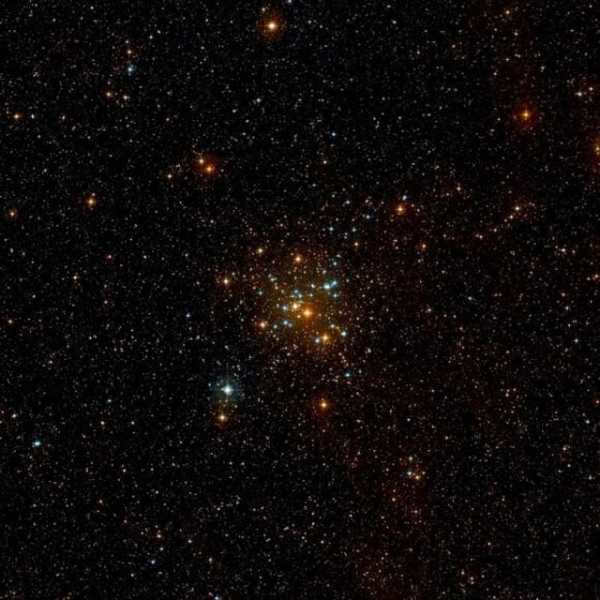
Messier 41
Ancient Greek legends about Sirius: 2 hypotheses about the star’s origin
Ancient Greeks made a significant contribution to the field of astronomy. In their attempts to explain natural phenomena, they put forth various theories. Sirius, the brightest star in the constellation Canis Major, received considerable attention. According to legend, Sirius was originally a dog.
The first myth recounts the story of a courageous hunter named Oreon (sometimes referred to as Actaeon). While venturing through the forest, the young man stumbled upon the goddess Artemis bathing in a refreshing spring.
Oreon was completely captivated by the exquisite beauty he beheld. However, his admiration was abruptly interrupted when Artemis, noticing the boy’s gaze, was consumed with anger. In her fury, the goddess transformed the hunter into a graceful deer. Tragically, Oreon was later attacked by his very own loyal dog, which would eventually become the inspiration for the renowned Big Dog constellation.
According to an alternate tale, the gracious god Dionysus, after being offered shelter for the night by the shepherd Icarius, graciously imparted his expertise in the art of winemaking as a token of gratitude. Eager to share his newfound knowledge, Icarius generously shared the craft with his fellow villagers.
Upon arriving in Attica, Icarius treated the locals to his marvelous wine. The townspeople, however, consumed it with such gusto that they became quite inebriated. Fearing that Icarius had intended to poison them, they unjustly executed him and concealed his lifeless body within the mountains. The shepherd’s daughter embarked on a desperate search for her father, but it was only her faithful dog Myra who was able to locate Icarius. Overwhelmed by the grief of her immeasurable loss, the young girl tragically took her own life, ending her relentless pursuit.
The residents of Attica suffered from diseases caused by the wrathful Dionysus, who transformed the shepherd Icarius, his daughter, and the faithful dog Myra into celestial bodies. As a result, three constellations emerged in close proximity: Virgo, Magpus, and Big Dog.

The star Sirius
The ancient astronomers and their observations of the Big Dog constellation
Ancient astronomers were always eager to witness the rising of Sirius. In Ancient Egypt, this star was known as Sopt, a name borrowed from the ancient Greeks, which translates to “brilliant”.
Roman astronomers referred to Sirius as “canicula”, meaning “dog”. The rise of Sirius was associated with the rise of the Sun, which brought about high temperatures and the outbreak of epidemics. To prevent mass illnesses, the Romans introduced “vacations” or “dog days” in their schools, during which it was considered dangerous to venture outdoors.
The Sumerians, who were ancient astronomers, referred to Sirius as the “sun’s canine companion”. They relied on its position to create horoscopes and make predictions.
Information about the constellation known as the Big Dog can be found in the star catalog “Almagest”. The author, Claudius Ptolemy, simply calls it the “Dog”.
What is the age of Sirius?
Astronomical experts estimate that Sirius is between 230 and 250 million years old. When observing this star from Earth, one can notice occasional fluctuations in its brightness, which are caused by its high velocity. The surface temperature of Sirius can reach up to 10,000 degrees.
Currently, Sirius emits a white light. However, ancient Greek poets and scientists believed that the brightest star in the constellation Canis Major emitted a “red light.” There is no scientific evidence to refute this claim. It is possible that in ancient times, the Canis Major constellation did emit a red light, as stars undergo changes in surface temperature and, consequently, their characteristic glow over time.
Is there a “companion star” to Sirius?
In 1834, Friedrich Wilhelm Bessel, a German scientist, was conducting astronomical research and noticed the movement and oscillation of Sirius. He theorized that the star had a companion. Bessel’s theory was later confirmed by American astronomer Alvan Clark almost three decades later. The companion star was named Sirius B, or “Puppy”. It has a diameter that is 100 times smaller than the Sun.
Sirius, the largest star in the constellation Canis Major, and its “companion” have the same mass, but Sirius shines 10,000 times brighter. The companion star, Puppy, belongs to the category of white dwarf stars. After completing its evolutionary cycle, it has transformed into a small planet.

